The mullet haircut, once considered a relic of the 1980s, is experiencing an unexpected renaissance in children’s hairstyling. Parents and young boys alike are embracing this distinctive “business in the front, party in the back” style with modern twists that make it fresh, fun, and surprisingly versatile.
The 27 Best Little Boy Mullet Haircuts Making a Comeback showcases how this iconic hairstyle has evolved from its retro roots into a contemporary trend that balances edginess with youthful charm.
From subtle, textured versions to bold, statement-making cuts, today’s little boy mullets offer something for every personality and hair type.
This comprehensive guide explores the various mullet styles that are capturing attention on playgrounds and social media, providing parents with inspiration and practical information to help their sons rock this trending look with confidence.
Whether you’re seeking a low-maintenance summer cut or a standout style for your adventurous child, this article walks you through the best mullet variations, styling tips, and maintenance advice to ensure your little one looks sharp and feels great.
Contents
- 1 1. The Classic Baby Mullet
- 2 2. The Modern Textured Mullet
- 3 3. The Curly Mullet
- 4 4. The Blonde Surfer Mullet
- 5 5. The Shaggy Mullet
- 6 6. The Punk Rock Mullet
- 7 7. The Business Mullet
- 8 8. The Athletic Mullet
- 9 9. The Retro 80s Mullet
- 10 10. The Asymmetrical Mullet
- 11 11. The Fade Mullet
- 12 12. The Long Back Mullet
- 13 13. The Textured Top Mullet
- 14 14. The Mullet with Bangs
- 15 15. The Colored Mullet
- 16 16. The Undercut Mullet
- 17 17. The Mullet with Hair Design
- 18 18. The Wavy Mullet
- 19 19. The Mini Mullet
- 20 20. The Side Part Mullet
- 21 21. The Choppy Mullet
- 22 22. The Slicked Back Mullet
- 23 23. The Natural Mullet
- 24 24. The Graduated Mullet
- 25 25. The Mohawk Mullet
- 26 26. The Tapered Mullet
- 27 27. The Flow Mullet
- 28 Maintenance Tips for Little Boy Mullets
- 29 Choosing the Right Mullet for Your Child
- 30 Styling Products and Tools for Boys’ Mullets
- 31 Common Mullet Mistakes to Avoid
- 32 Talking to Your Barber About Mullets
- 33 The Social Side of Boys’ Mullets
- 34 Mullet Hair Growth Timeline
- 35 Seasonal Mullet Considerations
- 36 Confidence and Self-Expression Through Mullets
- 37 Celebrity and Influencer Mullet Inspiration
- 38 The Future of Boys’ Mullet Trends
- 39 Conclusion
1. The Classic Baby Mullet
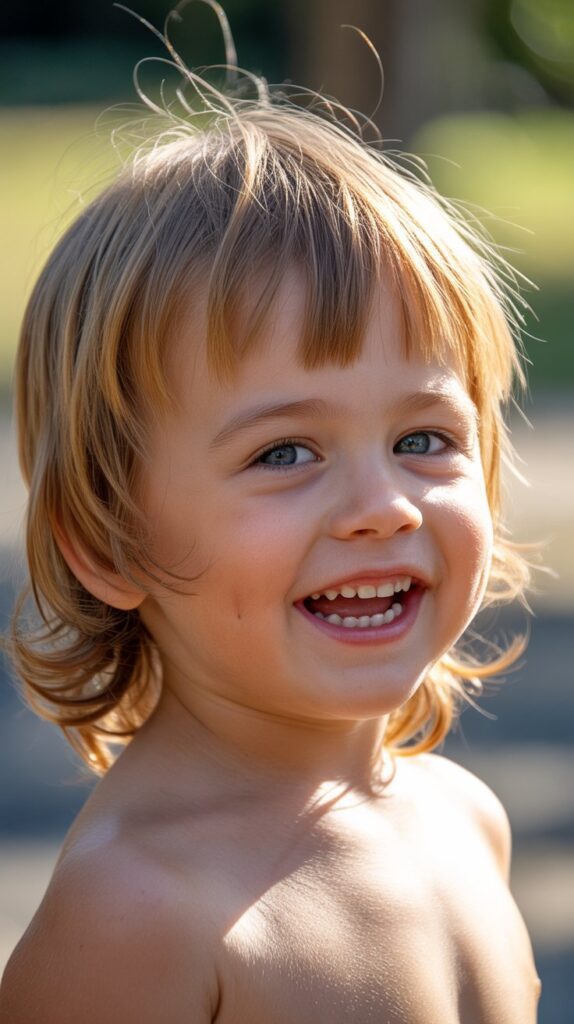
The classic baby mullet serves as the foundation for all modern variations, featuring shorter sides and front with noticeably longer hair in the back. This timeless style introduces young boys to the mullet trend without going too extreme, making it perfect for parents who want to test the waters.
Style Characteristics
- The front and top sections typically measure between one to two inches in length, providing enough volume for natural texture
- Side hair is cut close to the head, usually with clippers set to a medium guard, creating a clean contrast
- The back section extends past the collar, ranging from three to five inches depending on the child’s hair growth and parent preference
- This style works exceptionally well with straight to wavy hair textures, as the natural movement enhances the distinctive mullet shape
- Minimal styling is required, making it ideal for active toddlers and preschoolers who won’t sit still for elaborate grooming routines
Maintenance Requirements
- Regular trims every four to six weeks help maintain the distinct length differences between sections
- Simple shampooing and conditioning routines keep the hair healthy without complicated product applications
- The longer back section may require gentle detangling with a wide-tooth comb after baths
- Parents appreciate that this cut air-dries naturally without needing blow-drying or heat styling tools
2. The Modern Textured Mullet
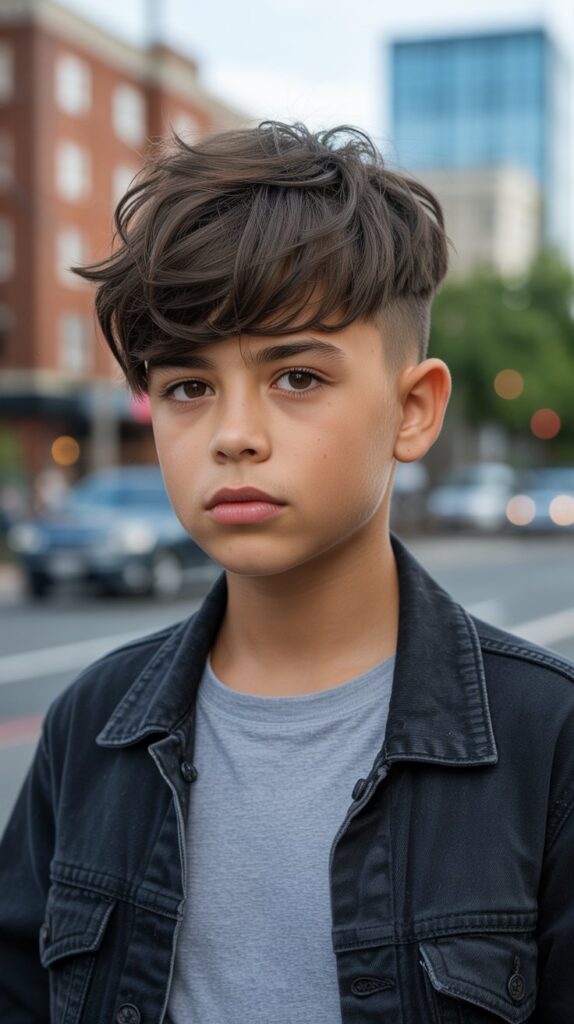
The modern textured mullet updates the classic style with choppy layers and intentional texture throughout all sections. This contemporary approach creates dimension and movement while maintaining the signature mullet silhouette.
Cutting Technique
- Barbers use point-cutting and razor techniques to create uneven, piecey layers that add visual interest
- The top section features varying lengths that create natural spikes and movement when styled
- Texture is distributed throughout the entire haircut rather than just in specific zones
- This approach works particularly well for boys with thick, coarse hair that can hold the textured shape
- The graduated layers blend more seamlessly from front to back compared to the stark contrast of traditional mullets
Styling Options
- A small amount of lightweight styling cream or sea salt spray enhances the textured appearance
- Parents can simply scrunch the hair while damp to encourage natural texture and waves
- The style looks intentionally tousled, which means imperfection is actually desirable
- This mullet variation transitions well from casual play to more formal occasions with minimal adjustment
3. The Curly Mullet
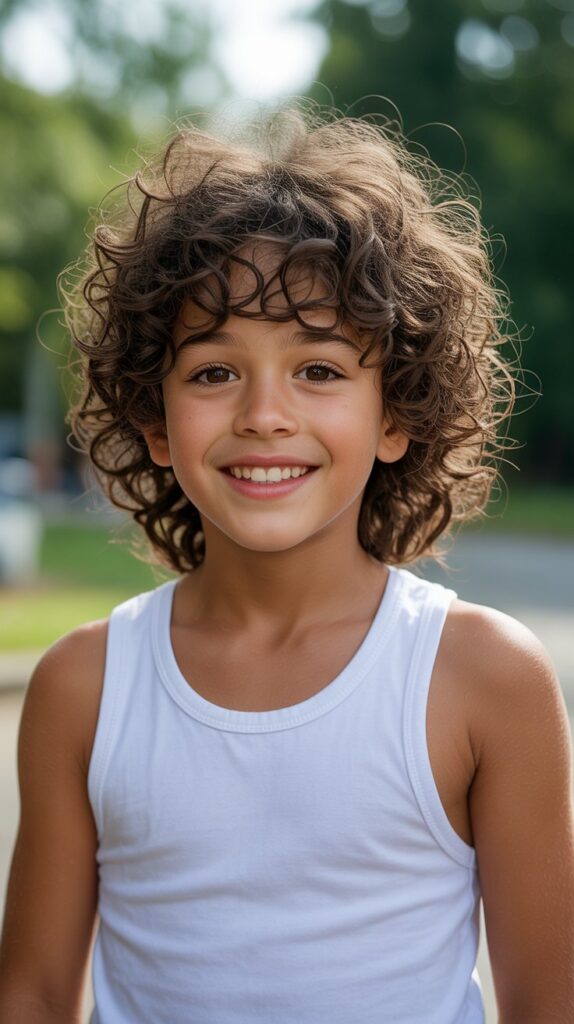
The curly mullet celebrates natural curl patterns while incorporating the distinctive mullet structure. This style allows boys with curly or coily hair to embrace their texture while participating in the mullet trend.
Working with Natural Texture
- The cut follows the natural curl pattern rather than fighting against it, creating a harmonious shape
- Shorter curls on top and sides spring up to create volume and frame the face beautifully
- The longer back section showcases full ringlets or waves that flow freely down the neck
- This style eliminates the need for straightening or chemical treatments, promoting healthier hair
- Curly mullets often appear fuller and more dramatic than their straight-hair counterparts due to the curl’s natural volume
Curl Care Essentials
- Moisturizing shampoos and leave-in conditioners prevent dryness and maintain curl definition
- Wide-tooth combs or finger-detangling work best to avoid disrupting the curl pattern
- The “pineapple” method (gathering hair loosely on top) helps preserve curls overnight
- Regular deep conditioning treatments keep the longer back section healthy and bouncy
- Parents should avoid brushing dry curls, which can cause frizz and damage the curl structure
4. The Blonde Surfer Mullet

The blonde surfer mullet embodies carefree beach vibes with sun-kissed tones and effortlessly tousled waves. This style captures the essence of coastal cool and works beautifully for boys with naturally light hair.
Achieving the Look
- Natural blonde hair provides the perfect base, though subtle highlights can enhance dimension
- The cut maintains medium length on top with deliberately uneven layers for movement
- Side sections are kept shorter but not too tight, allowing some wave texture to show
- The back flows longer with soft, beachy waves that suggest hours spent in sun and saltwater
- This style particularly suits boys with fine to medium hair texture that naturally develops wave patterns
Maintenance and Protection
- Sun exposure can lighten hair naturally, but protective products prevent excessive drying
- Purple-toning shampoos used occasionally can prevent brassiness in lighter blonde shades
- Leave-in conditioners with UV protection maintain hair health during outdoor activities
- The intentionally messy nature means styling takes just minutes with texture spray
- Regular swimming actually enhances the style when followed by proper rinsing and conditioning
5. The Shaggy Mullet
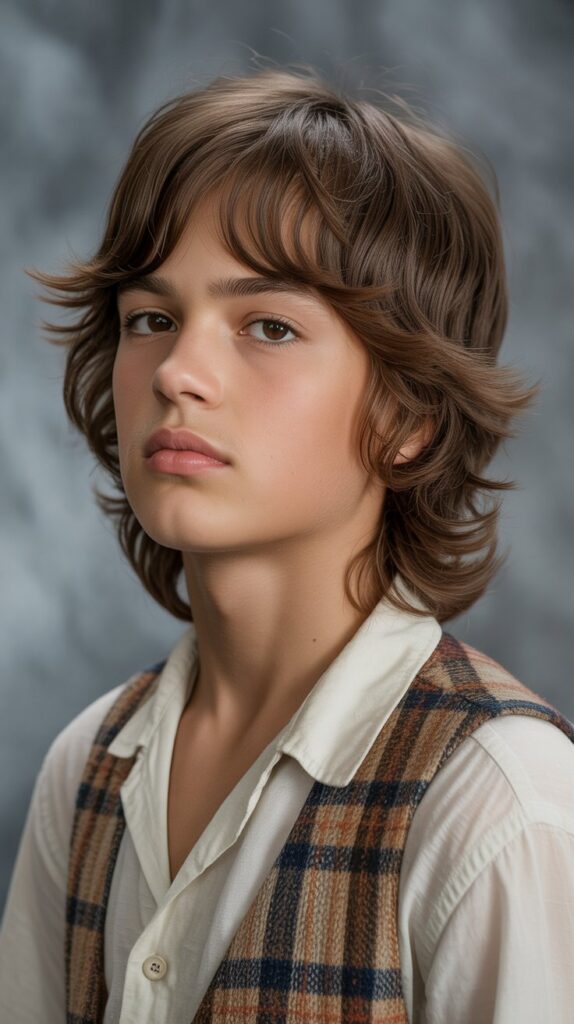
The shaggy mullet combines elements of the 1970s shag cut with classic mullet proportions, creating a softer, more bohemian appearance. This style suits boys with relaxed, artistic personalities.
Layering Strategy
- Multiple layers throughout create a feathered effect that softens the overall appearance
- The front bangs fall across the forehead and can be swept to the side or worn straight
- Layers frame the face gently rather than creating harsh lines or dramatic contrasts
- The back section features long, soft layers that blend seamlessly with the shorter top
- This cut works exceptionally well for boys with straight or slightly wavy hair that can hold the feathered shape
Versatile Styling
- The shaggy mullet looks equally appropriate for school, family gatherings, or casual weekend activities
- Air-drying creates a natural, lived-in appearance that requires no special effort
- A round brush and blow-dryer can add volume and direction for more polished occasions
- The longer front bangs can be styled multiple ways depending on the child’s mood or activity
- This style grows out gracefully, requiring less frequent salon visits than more structured cuts
6. The Punk Rock Mullet
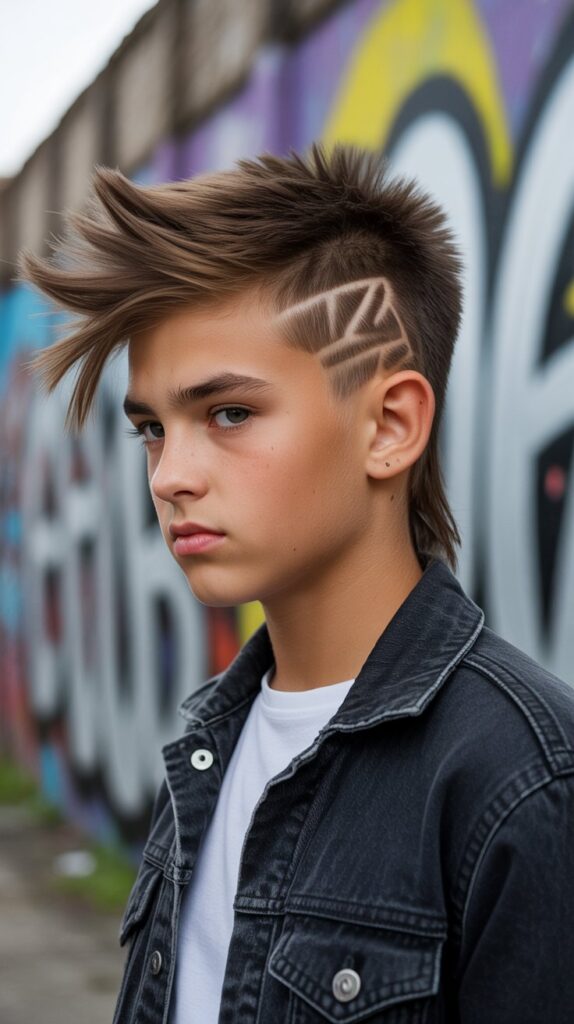
The punk rock mullet makes a bold statement with dramatic contrasts, edgy styling, and attitude to spare. This rebellious style suits confident boys who want to stand out from the crowd.
Distinctive Features
- The top section is cut to allow for significant height when styled upward with product
- Sides are often shaved very short or feature geometric designs and patterns
- The back maintains substantial length, sometimes reaching shoulder level for maximum impact
- Color experimentation, such as temporary dyes or highlights, often accompanies this style
- The stark contrast between sections creates an unmistakably bold appearance
Styling Requirements
- Strong-hold gel, pomade, or styling paste is necessary to achieve and maintain the spiky top
- The styling process takes more time and effort compared to low-maintenance mullet variations
- Parents should be prepared for daily styling routines before school or activities
- The dramatic nature of this cut means it makes a strong impression and isn’t for everyone
- Regular maintenance appointments every three to four weeks keep the style looking sharp
7. The Business Mullet
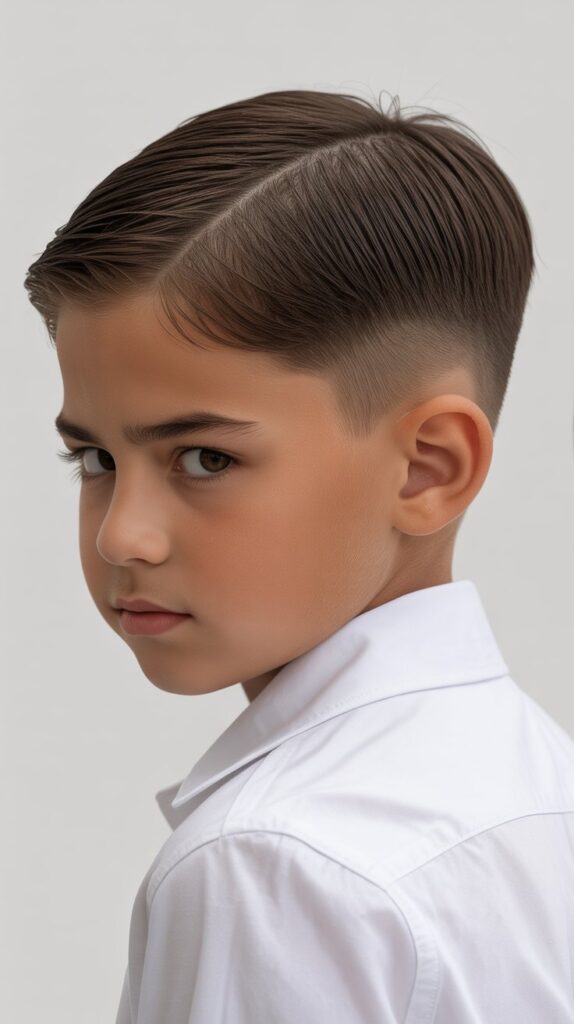
The business mullet offers a more refined interpretation of the style, keeping proportions conservative while maintaining the classic structure. This version suits families who want to participate in the trend while staying relatively traditional.
Professional Proportions
- The front and top sections are kept neat and trim, similar to a traditional boy’s haircut
- Sides feature a clean taper fade that creates a polished, groomed appearance
- The back extends only slightly past the collar, offering a hint of mullet style without extremes
- This cut passes dress codes for schools with stricter grooming policies
- The overall effect suggests intentional styling rather than lack of care
Appropriate Occasions
- This mullet variation works well for boys who attend private schools or formal events regularly
- The style photographs nicely for school pictures and family portraits
- It can be dressed up or down depending on how the hair is styled
- Parents who are hesitant about more extreme versions often feel comfortable with this approach
- The conservative length in back makes it less controversial among extended family members
8. The Athletic Mullet

The athletic mullet combines functionality with style, designed for active boys who participate in sports and outdoor activities. This practical variation keeps hair manageable while maintaining trendy appeal.
Functional Design
- The top and sides are kept short enough to avoid interference with sports helmets and equipment
- Sweat management is built into the cut, with shorter sections that dry quickly
- The back provides enough length to satisfy the mullet aesthetic without becoming a hindrance
- This style works across all sports, from soccer and basketball to swimming and martial arts
- The low-maintenance nature appeals to busy families with packed athletic schedules
Performance Benefits
- Hair stays out of the eyes during intense activity without requiring constant adjustment
- The cut doesn’t create pressure points under protective headgear like helmets or caps
- Quick shower-and-go styling gets kids ready for practice or games efficiently
- The style maintains its shape even after being compressed under hats or equipment
- Parents appreciate the balance between trendiness and practicality for their athlete
9. The Retro 80s Mullet
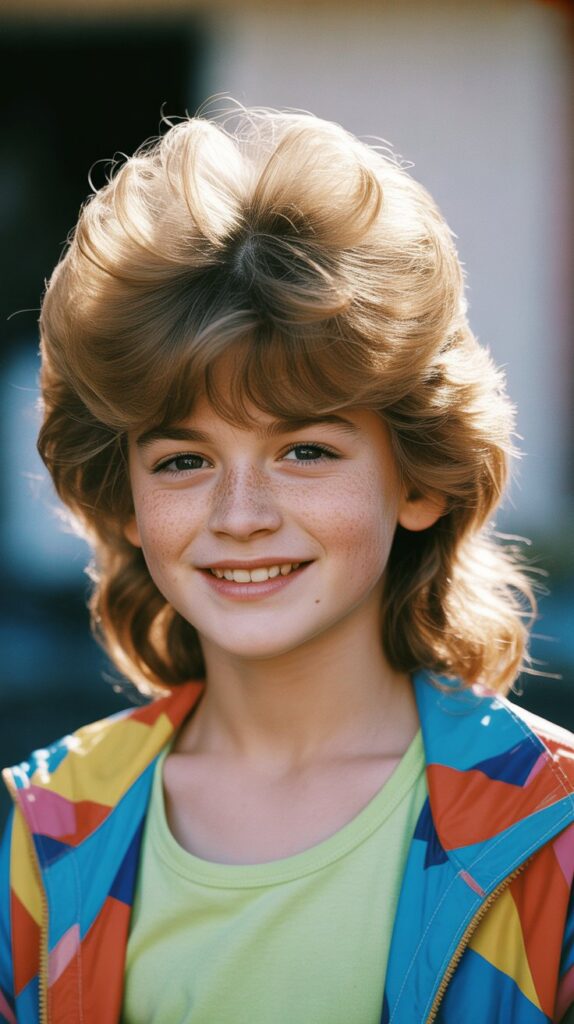
The retro 80s mullet faithfully recreates the iconic decade’s signature style with period-appropriate proportions and attitude. This nostalgic choice appeals to families who appreciate vintage aesthetics.
Authentic Period Details
- The top section features significant volume, sometimes achieved through perming or teasing techniques
- Sides are cut shorter but not skin-tight, maintaining the softer aesthetic of 1980s styling
- The back section extends well past the shoulders in true decade-authentic fashion
- This version makes no apologies and fully embraces the original mullet philosophy
- The style often pairs with vintage clothing choices for complete retro coordination
Modern Adaptations
- While honoring the original, contemporary versions typically use healthier hair practices
- Chemical treatments are optional rather than essential for achieving the look
- Parents can choose how literal to interpret the 80s aesthetic for their child
- This style works well for themed parties, Halloween costumes, or families with retro sensibilities
- The dramatic nature makes it a conversation starter and photo opportunity
10. The Asymmetrical Mullet
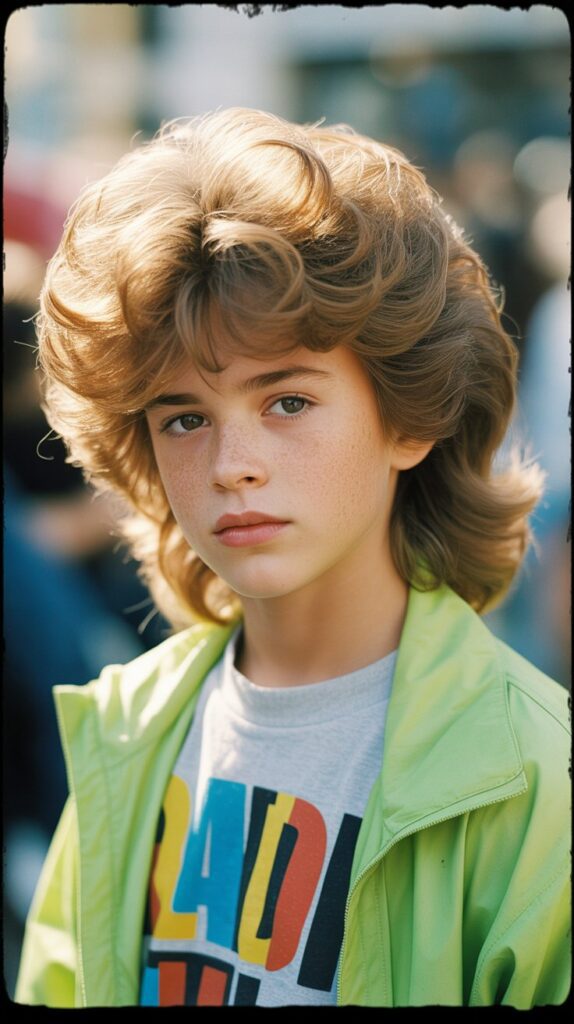
The asymmetrical mullet introduces unexpected angles and uneven lengths to create artistic interest. This avant-garde approach suits creative kids and fashion-forward families.
Artistic Elements
- One side is deliberately cut shorter than the other, creating visual intrigue
- The front section may angle dramatically from one side to the other
- Back length can vary from one side to the opposite, adding movement and dimension
- This style requires a skilled barber or stylist who understands asymmetrical cutting techniques
- The unconventional nature appeals to boys with artistic interests and unique personalities
Styling Possibilities
- The asymmetry allows for multiple styling options depending on how the hair is parted or combed
- Different angles create different looks, providing variety within a single haircut
- This style photographs particularly well from various angles due to its dimensional nature
- Styling products can enhance or soften the asymmetrical elements based on preference
- The cut makes a strong fashion statement that sets the wearer apart from peers
11. The Fade Mullet
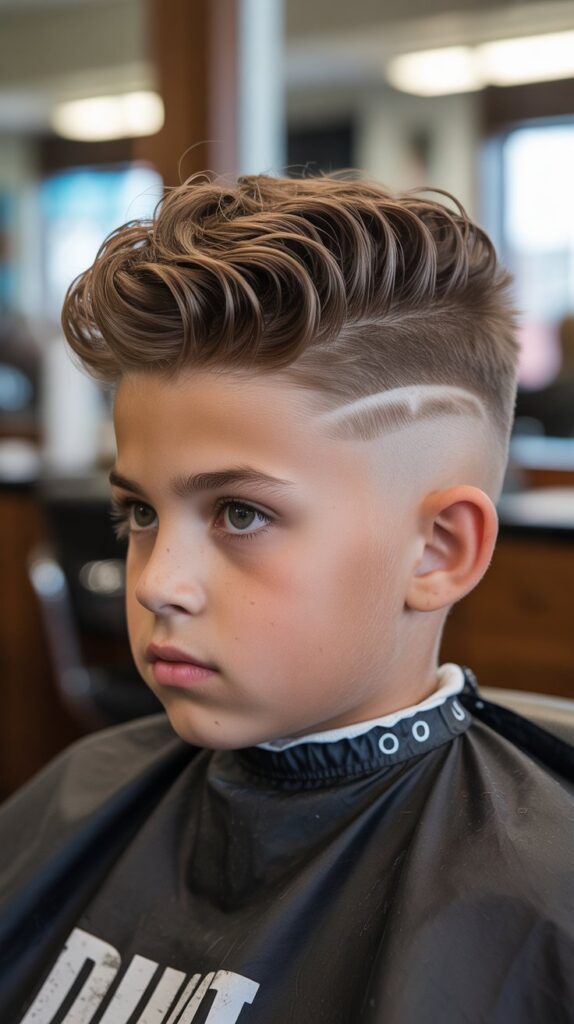
The fade mullet combines modern barbering techniques with classic mullet structure, featuring graduated fades on the sides that blend seamlessly into the longer back section. This contemporary fusion creates a clean, polished appearance.
Technical Precision
- A high, mid, or low fade on the sides creates a gradient effect from skin to longer hair
- The fade typically starts above the ears and graduates smoothly up the sides
- Sharp edge-ups and line work around the hairline provide clean definition
- The top maintains enough length for styling while the back flows longer naturally
- This style showcases barbering skill and attention to technical detail
Maintenance Schedule
- Fades require more frequent maintenance, typically every two to three weeks, to stay sharp
- The precise lines and gradients need professional upkeep to avoid looking grown out
- Between appointments, the style still looks presentable but gradually loses its crisp appearance
- Parents should budget for regular barbershop visits to maintain the look properly
- The investment in frequent trims pays off in consistently polished appearance
12. The Long Back Mullet

The long back mullet emphasizes dramatic length in the rear section, creating maximum impact and embracing the “party in the back” philosophy fully. This bold choice suits boys who want an unmistakable statement style.
Length Considerations
- The back section extends to shoulder level or beyond, creating significant visual impact
- This length requires several months to a year of growth to achieve fully
- Boys must be comfortable with hair touching their neck and shoulders throughout the day
- The dramatic contrast between short front and long back makes the style unmistakable
- This version fully commits to the mullet aesthetic without reservation
Long Hair Care
- The extended length requires regular conditioning treatments to prevent dryness and tangles
- Detangling spray or leave-in conditioner makes combing easier after washing
- Some boys choose to braid or tie back the long section during sports or active play
- Split end prevention becomes important with this much length
- Parents should teach proper hair care routines to help children maintain healthy long hair
13. The Textured Top Mullet
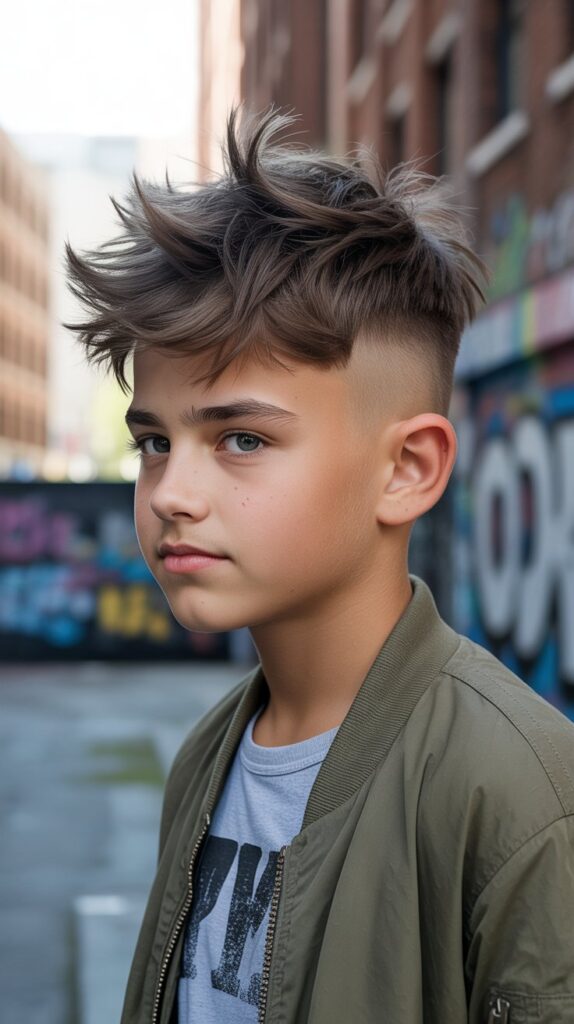
The textured top mullet features heavily styled and textured upper sections that contrast with sleeker back lengths. This style emphasizes the “business in the front” concept through deliberate top section styling.
Top Section Focus
- The top hair is cut in varying lengths and layers to maximize texture potential
- Styling products create deliberate spikes, twists, or piecey separation in the upper section
- This focus draws attention upward while the back provides balance and interest
- The contrast between textured top and smooth back creates visual intrigue
- This style particularly suits boys with thick hair that holds texture well
Product Recommendations
- Matte finish clay or paste provides texture without shine for a modern look
- Light-hold mousse can add texture to finer hair without weighing it down
- Texturizing spray offers an easy application method for younger children
- Avoid heavy pomades or gels that create a wet look inconsistent with the style
- A small amount of product goes a long way for children’s fine hair
14. The Mullet with Bangs
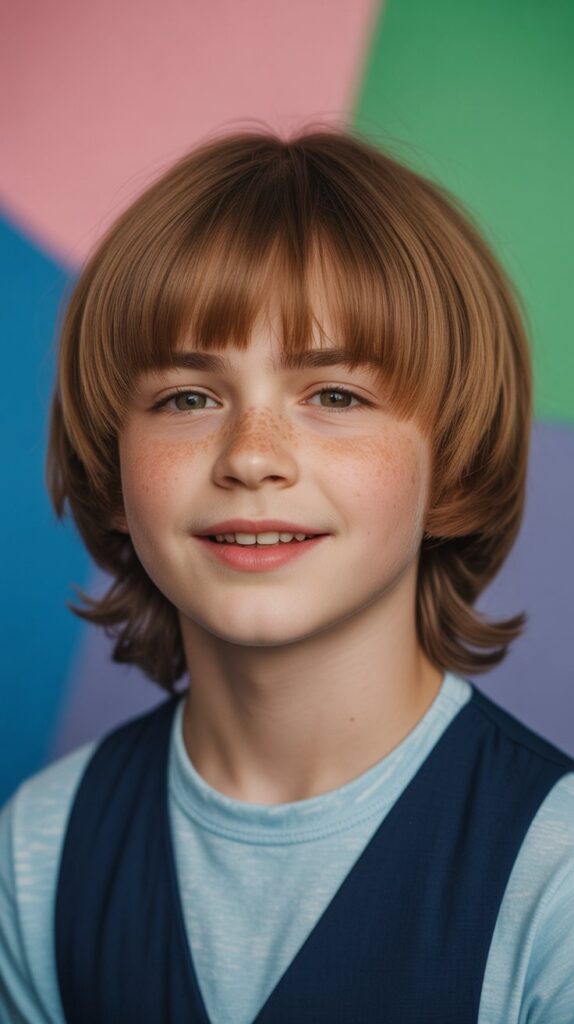
The mullet with bangs incorporates a distinct fringe element across the forehead, adding another dimension to the traditional mullet structure. This variation creates additional styling versatility.
Fringe Variations
- Straight-across bangs create a bold, geometric statement that frames the eyes
- Side-swept bangs offer a softer, more casual interpretation of the fringe element
- Choppy, textured bangs add an edgy element that complements the mullet’s rebellious nature
- The length of bangs can vary from eyebrow-grazing to forehead-covering based on preference
- This style works well for boys who enjoy having hair to play with or push aside
Practical Considerations
- Bangs require more frequent trims than the rest of the haircut to stay out of eyes
- Parents should monitor whether bangs obstruct vision during activities or schoolwork
- Some boys love the face-framing effect while others find bangs annoying
- The addition of bangs makes the overall style more high-maintenance than simpler mullet versions
- Styling the bangs adds an extra step to the daily hair routine
15. The Colored Mullet
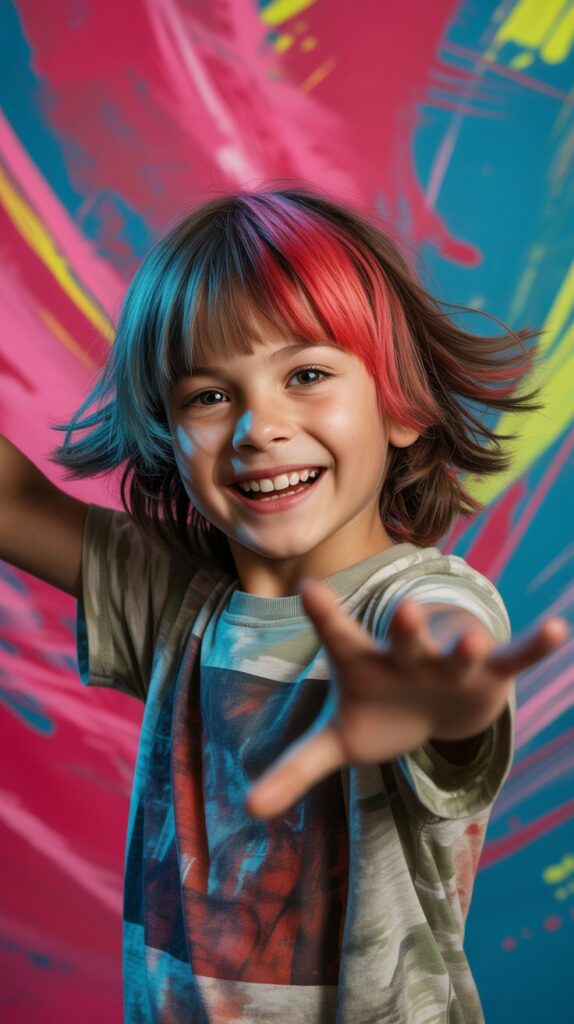
The colored mullet incorporates temporary or semi-permanent hair color to add extra personality and flair. This creative approach allows for self-expression beyond just the haircut structure.
Color Options
- Temporary hair chalk or spray washes out completely, perfect for special occasions or weekends
- Semi-permanent dyes last several weeks, suitable for boys who want longer-term color
- Highlights or ombre effects create dimension without full color saturation
- Bold colors like blue, purple, or red make strong statements and photograph dramatically
- Natural tones like caramel or honey highlights offer subtle enhancement
Application Guidelines
- Always use products specifically formulated for children’s sensitive scalps
- Perform patch tests before applying any color product to check for reactions
- Temporary options allow experimentation without long-term commitment
- Consider school dress codes before choosing permanent or long-lasting colors
- Professional application ensures even coverage and minimizes damage risk
16. The Undercut Mullet
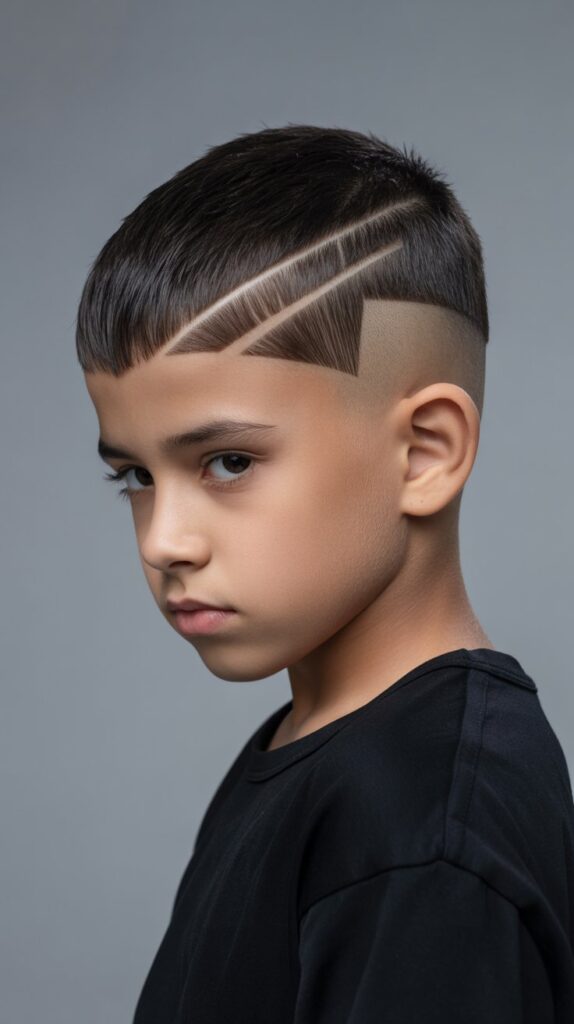
The undercut mullet features shaved or very short sides that create dramatic contrast with both the top and back sections. This modern interpretation combines trending undercut techniques with classic mullet structure.
Structural Elements
- The undercut creates a visible “shelf” or disconnect between short sides and longer sections above
- This dramatic contrast emphasizes the intentional nature of the style
- The top and back appear to sit on top of the shorter sides rather than blending gradually
- Sharp lines define where the undercut ends and longer hair begins
- This style makes a bold statement and requires confidence to wear
Maintenance Intensity
- The undercut grows out noticeably and requires regular maintenance every two to three weeks
- Between cuts, the style loses its sharp definition as the short sections grow longer
- This higher maintenance commitment may not suit all families’ schedules or budgets
- The dramatic nature means the style looks best when freshly cut
- Parents should consider whether they can commit to frequent barbershop visits
17. The Mullet with Hair Design
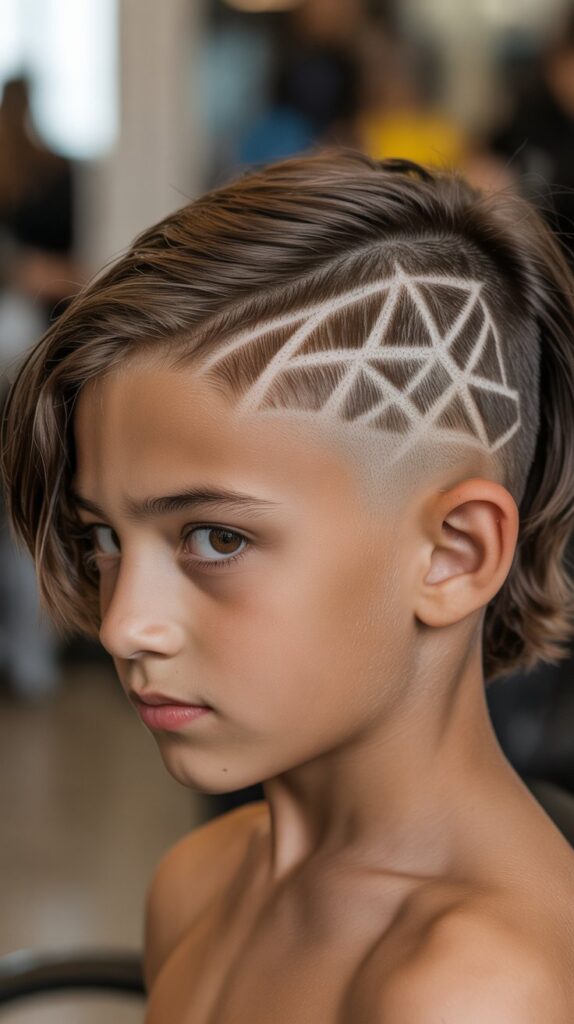
The mullet with hair design incorporates shaved patterns, lines, or artwork into the shorter side sections. This customization adds personal flair and showcases barbering artistry.
Design Possibilities
- Simple lines or stripes provide clean geometric interest without excessive complexity
- Geometric patterns like triangles, zigzags, or curves showcase technical skill
- Sports logos, lightning bolts, or other symbols represent personal interests
- The designs appear on the shorter side sections where they’re most visible
- Skilled barbers can create surprisingly intricate artwork using only clippers
Temporary Nature
- Hair designs grow out quickly, typically becoming less distinct after one to two weeks
- This temporary nature allows for changing designs at each haircut appointment
- Boys enjoy choosing new designs regularly, making each visit to the barber exciting
- The changing designs keep the mullet style fresh and interesting
- As designs fade, they provide a natural indicator that it’s time for a maintenance trim
18. The Wavy Mullet
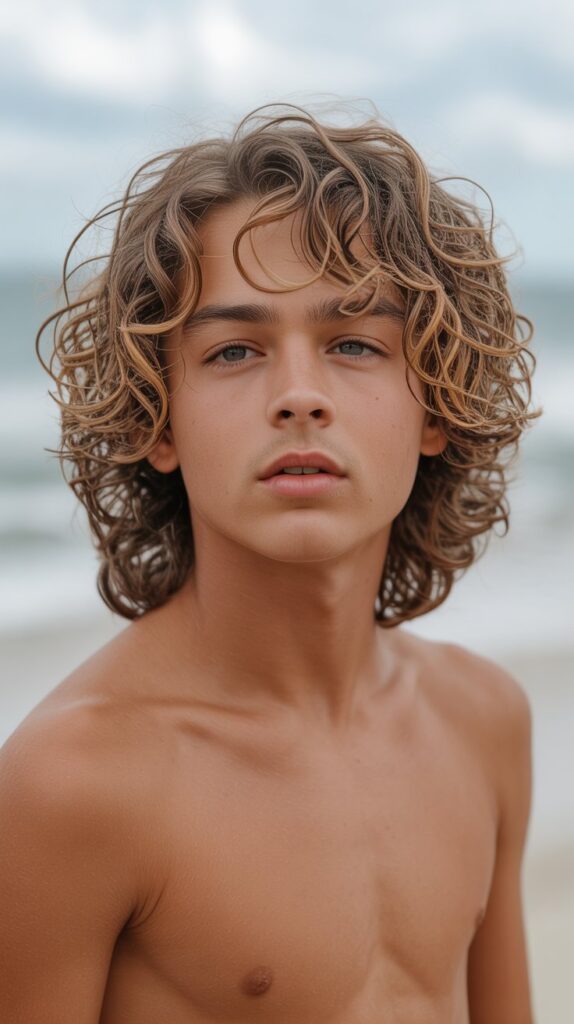
The wavy mullet celebrates natural wave patterns throughout all sections of the haircut. This style allows boys with wavy hair to embrace their texture while rocking the trendy mullet shape.
Working with Waves
- The cut follows natural wave patterns rather than trying to control or straighten them
- Waves add natural movement and dimension to both the top and back sections
- This texture type creates a softer, more romantic interpretation of the mullet style
- The waves provide built-in interest without requiring extensive styling effort
- This style works beautifully for boys who resist heavy styling routines
Wave Enhancement
- Sea salt spray enhances natural waves and adds beachy texture
- Scrunching hair while damp encourages wave formation
- Diffuser attachments on blow-dryers set waves without creating frizz
- Avoid brushing dry wavy hair, which disrupts the wave pattern
- Light-hold products maintain waves without making hair crunchy or stiff
19. The Mini Mullet
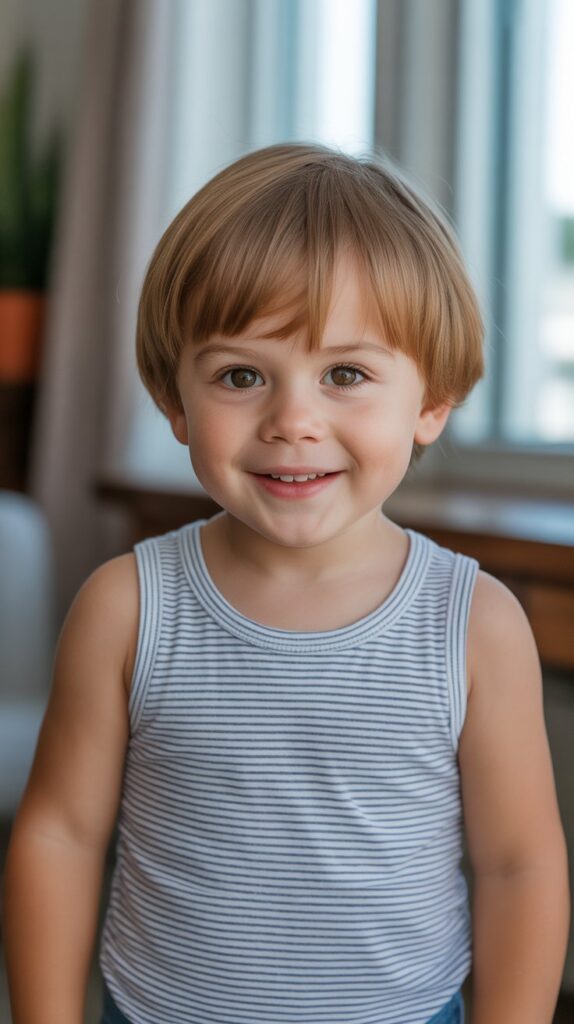
The mini mullet offers a scaled-down version of the classic style, perfect for toddlers and very young boys. This approachable introduction to the mullet trend features subtle proportions appropriate for little ones.
Age-Appropriate Proportions
- The length differences between sections are subtle rather than dramatic
- This gentle introduction to the mullet style suits young children who are still growing their first full head of hair
- The back extends only slightly past the collar, creating a hint of mullet shape
- Fine baby hair texture affects how the style appears compared to older children’s thicker hair
- This version rarely looks out of place or too trendy for traditional family members
Practical Benefits
- Very young children won’t sit still for lengthy styling sessions, making simplicity essential
- The minimal length differences require little to no daily maintenance
- Parents can easily manage this style at home between professional cuts
- The cute factor appeals to family members even if they’re skeptical of mullet trends
- This style grows out gracefully as the child’s hair continues developing
20. The Side Part Mullet

The side part mullet incorporates a defined side part into the traditional mullet structure, adding a preppy or vintage element. This style balances edgy and refined aesthetics.
Parting Techniques
- A sharp, defined part on one side creates a clean line that adds structure
- The parted top section can be combed neatly for formal occasions
- This element makes the overall style appear more intentional and groomed
- The part provides a starting point for styling the top section in a specific direction
- This detail elevates the mullet from casual to slightly more sophisticated
Styling Versatility
- The side part can be emphasized for dressier events or relaxed for casual settings
- Combing products help hold the part in place throughout the day
- The style works well for school pictures and family gatherings
- Parents appreciate the ability to dress the style up or down as needed
- This version satisfies both trendy and traditional styling preferences
21. The Choppy Mullet
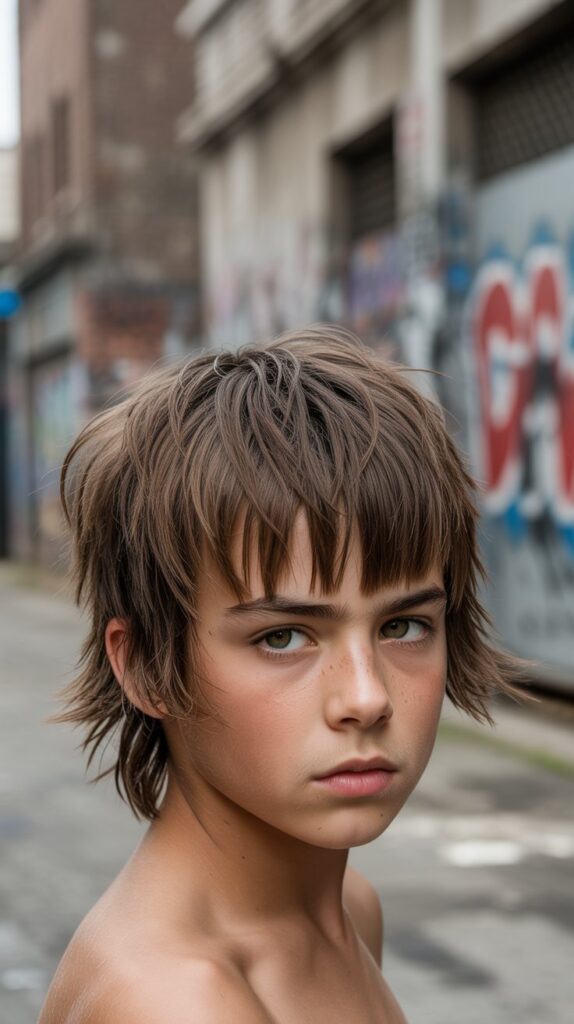
The choppy mullet features intentionally uneven, razor-cut layers throughout all sections creating an edgy, punk-inspired aesthetic. This deliberately rough-hewn approach celebrates imperfection and texture.
Cutting Method
- Razors and point-cutting techniques create jagged, irregular edges rather than blunt lines
- The choppy texture appears throughout the entire haircut, not just in specific zones
- This approach adds significant visual interest and movement to the style
- The uneven nature means the style looks intentionally messy rather than unkempt
- Skilled stylists create controlled chaos that appears effortless
Style Personality
- This mullet variation suits rebellious, creative personalities who reject conventional neatness
- The choppy texture adds edge and attitude to the overall appearance
- Parents should be comfortable with their child’s hair looking deliberately disheveled
- This style pairs well with alternative fashion choices and expressive personal style
- The rough texture softens as hair grows, creating a constantly evolving look
22. The Slicked Back Mullet
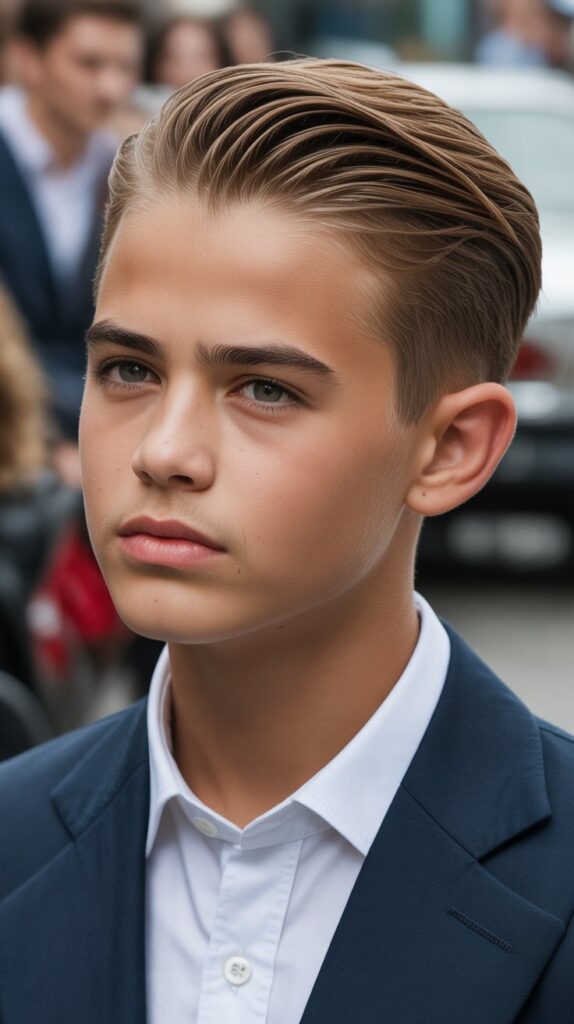
The slicked back mullet features a prominently styled top section combed backward, creating a rockabilly or greaser-inspired aesthetic. This polished approach contrasts smooth styling with the casual back section.
Styling Process
- Pomade, gel, or styling cream slicks the top section straight back from the forehead
- This technique creates height and volume while displaying the forehead prominently
- The smooth, shiny finish on top contrasts with the more natural back section
- This style references vintage 1950s and rockabilly aesthetics
- The polished top section makes the overall look more sophisticated
Product Selection
- Medium to high-hold pomade provides the necessary control and shine
- Water-based products wash out more easily than oil-based alternatives
- A small amount applied to damp hair distributes evenly for best results
- A fine-tooth comb helps achieve the smooth, polished finish
- Reapplication throughout the day may be necessary for active children
23. The Natural Mullet

The natural mullet embraces minimal cutting and styling, allowing hair to grow into the mullet shape organically. This low-intervention approach suits families who prefer simplicity and natural beauty.
Minimal Intervention
- The haircut involves basic shaping rather than dramatic cutting or styling
- Hair is allowed to grow naturally with minimal product use or heat styling
- This approach celebrates the child’s natural hair texture and growth patterns
- Regular trims maintain the general shape without precise technical work
- The overall effect is relaxed, casual, and effortlessly cool
Natural Hair Health
- Avoiding excessive styling and product use promotes healthier hair
- Natural oils distribute throughout the hair without product interference
- This approach suits sensitive scalps that react to styling products
- Children can participate in the mullet trend without complicated grooming routines
- The style works with rather than against natural hair characteristics
24. The Graduated Mullet
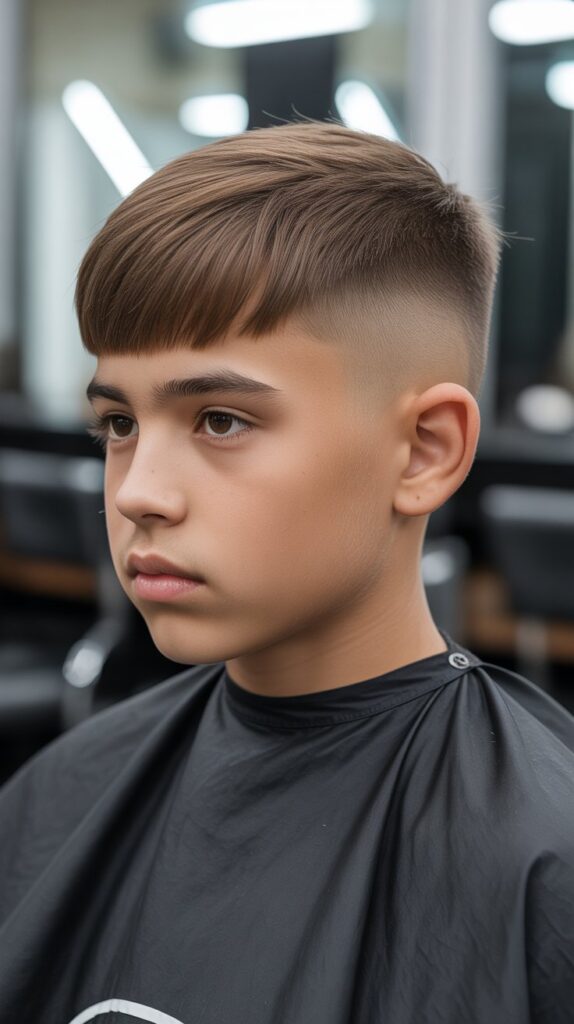
The graduated mullet features carefully blended transitions between length zones, creating a softer interpretation of the classic style. This technical approach demonstrates precision cutting skills.
Blending Technique
- Rather than stark contrasts, the lengths gradually increase from front to back
- The smooth gradation creates a more subtle, sophisticated appearance
- This approach suits parents who like the mullet concept but prefer less dramatic styling
- The technical cutting creates a polished, professional finish
- The graduated style photographs well and suits various occasions
Universal Appeal
- This version of the mullet faces less resistance from skeptical family members
- The subtle nature makes it appropriate for more conservative settings
- Schools with strict grooming policies may find this interpretation acceptable
- The style demonstrates intentional cutting rather than neglect
- This approach introduces children to the trend without committing to extremes
25. The Mohawk Mullet
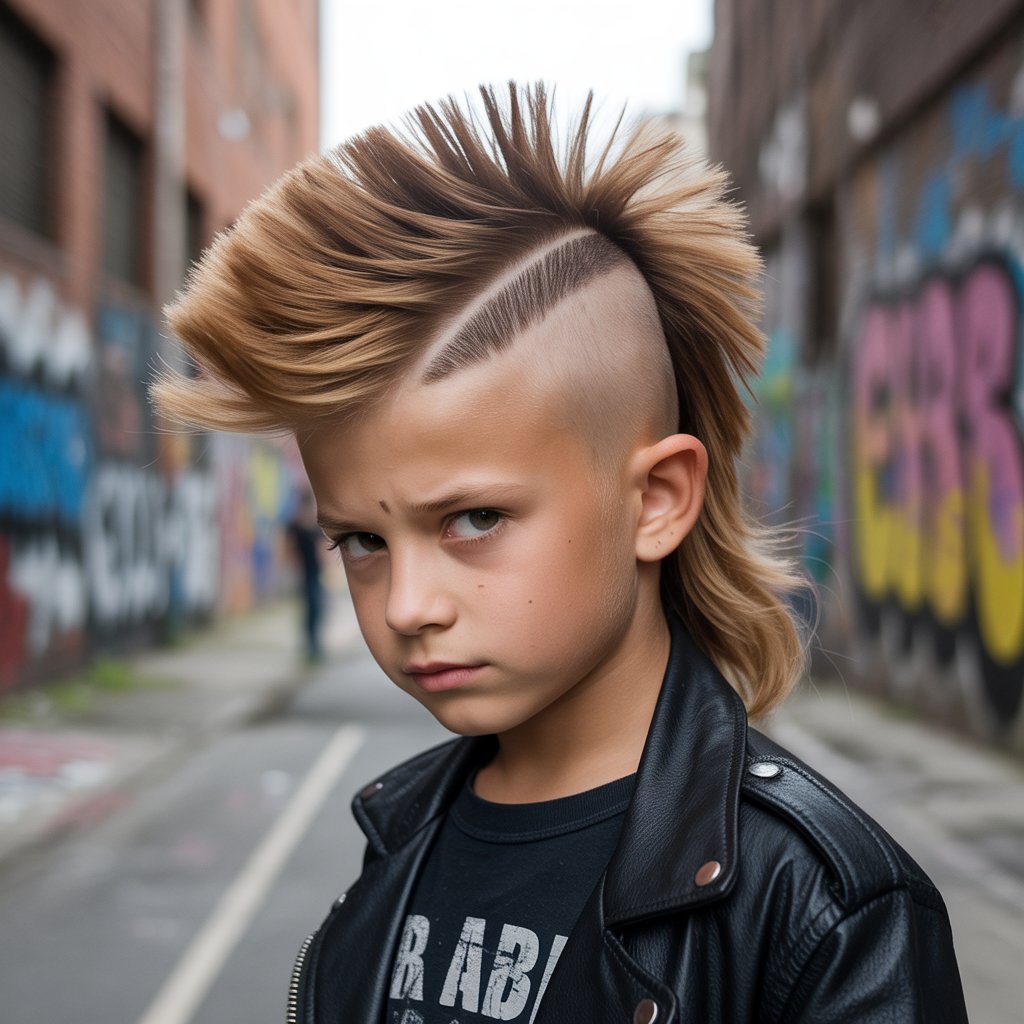
The mohawk mullet combines two iconic alternative hairstyles into one bold statement. This fusion features a raised center section flanked by shorter sides, with the signature long back completing the look.
Dual Style Elements
- The center section from forehead to crown stands tall like a traditional mohawk
- Sides are cut short or shaved to emphasize the raised center strip
- The back maintains substantial length true to mullet principles
- This combination creates one of the most dramatic and attention-getting variations
- The style requires significant confidence and personality to carry off successfully
Styling Commitment
- Achieving the raised mohawk section requires daily styling with strong-hold products
- The dramatic nature means the style makes a powerful impression everywhere
- Parents should ensure their child genuinely wants this attention-getting look
- The style may not be appropriate for all social or academic environments
- This mullet variation represents the boldest possible interpretation of the trend
26. The Tapered Mullet
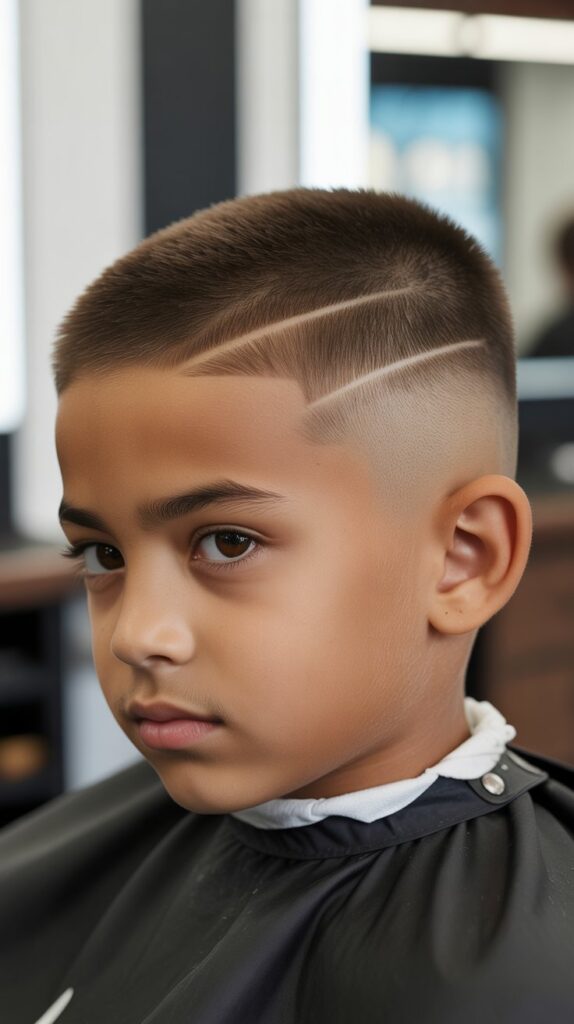
The tapered mullet features sides that gradually decrease in length as they move down toward the neckline, creating clean lines and a refined appearance. This modern approach adds barbering precision to the classic style.
Technical Precision
- The taper creates smooth transitions from longer hair at the top of the sides to shorter hair near the ears
- This technique requires clipper skills and attention to detail for seamless results
- The clean lines and precise work elevate the overall appearance
- The taper adds sophistication while maintaining the essential mullet structure
- This approach demonstrates professional barbering technique
Professional Appearance
- The tapered sides create a groomed look appropriate for various settings
- This version balances trendy appeal with conventional neatness
- The precision cutting shows that the style is intentional rather than neglected
- Parents appreciate the polished appearance for school and family events
- The technical work justifies the cost of professional barbering services
27. The Flow Mullet

The flow mullet maximizes movement and natural hair motion in the back section, creating a flowing, dynamic appearance. This style emphasizes the “party in the back” philosophy through length and movement.
Movement Emphasis
- The back section is cut to encourage maximum flow and movement when the child is active
- Layers in the back section enhance natural motion rather than creating static length
- This style looks particularly striking during sports, running, or outdoor play
- The flowing nature adds drama and visual interest to the overall appearance
- Hair appears to have personality and life of its own
Active Lifestyle Friendly
- The dynamic nature of this style suits energetic boys who are constantly moving
- The flow effect occurs naturally during play without requiring specific styling
- Parents enjoy how photogenic this mullet variation is during action shots
- The movement keeps the style from looking stiff or overly controlled
- This version celebrates the fun, carefree spirit associated with childhood
Maintenance Tips for Little Boy Mullets
Proper maintenance keeps any mullet variation looking fresh and intentional rather than neglected. These universal tips apply across all the styles featured in this article.
Regular Trimming Schedule
- Most mullet styles benefit from professional attention every four to six weeks
- More technical styles like fades and undercuts require more frequent visits every two to three weeks
- Mark calendar reminders to prevent the style from becoming overgrown
- Establish a relationship with a skilled barber who understands children’s cutting
- Consistent maintenance makes the difference between trendy and unkempt appearances
Home Care Routines
- Use gentle, child-appropriate shampoos and conditioners that won’t irritate sensitive scalps
- Detangling spray helps manage longer back sections, especially for active boys
- Wide-tooth combs work better than brushes for preventing breakage and tears
- Night-time routines might include braiding longer sections to prevent tangling during sleep
- Keep styling products minimal and age-appropriate for children’s delicate hair
Product Recommendations
- Choose lightweight, easy-to-wash-out products rather than heavy pomades or waxes
- Sea salt spray and texturizing products work well for casual, natural-looking styles
- Light-hold gels or mousses provide structure without crunchiness or residue
- Always perform patch tests with new products to check for allergic reactions
- Store products safely out of reach when not in use
Choosing the Right Mullet for Your Child
Selecting the perfect mullet variation depends on multiple factors including hair type, lifestyle, personality, and practical considerations. This guidance helps parents make informed decisions.
Lifestyle Factors
- Athletic children benefit from shorter, more manageable variations that won’t interfere with sports equipment
- Boys who dislike hair touching their necks should opt for shorter back sections
- Active outdoor kids naturally suit flowing, movement-focused styles
- Children with busy schedules need low-maintenance options requiring minimal daily styling
- Consider whether your child will cooperate with daily styling routines before choosing high-maintenance cuts
Personality Matching
- Bold, confident personalities can carry off dramatic styles like the mohawk mullet or punk rock variations
- Shy or reserved children might prefer subtle interpretations like the business or graduated mullets
- Creative, artistic boys often gravitate toward asymmetrical or colored versions
- Traditional kids may feel most comfortable with classic or natural approaches
- Let your child participate in the decision to ensure they’ll feel confident wearing the style
School and Social Considerations
- Review school dress codes and grooming policies before committing to extreme variations
- Consider extended family reactions if maintaining family harmony is important
- Discuss the style with your child’s other parent or guardians to ensure agreement
- Think about upcoming events like school pictures, weddings, or formal occasions
- Remember that hair grows back, so temporary experimentation causes no permanent consequences
Styling Products and Tools for Boys’ Mullets
Having the right products and tools makes maintaining and styling little boy mullets significantly easier. This section covers essential items for various mullet types.
Essential Styling Products
- Lightweight Styling Cream: Provides light hold and texture without heaviness, perfect for daily wear
- Sea Salt Spray: Creates beachy, tousled texture with minimal effort, ideal for casual styles
- Matte Clay or Paste: Offers strong hold with no shine for modern, textured looks
- Leave-In Conditioner: Maintains moisture and manageability, especially important for longer back sections
- Texturizing Powder: Adds volume and grip to fine hair without visible product residue
Useful Tools
- Wide-Tooth Comb: Gentle detangling for wet hair and longer sections without causing breakage
- Fine-Tooth Comb: Creates clean parts and smooth styling for more polished looks
- Round Brush: Adds volume during blow-drying for styles requiring lift and direction
- Hair Dryer with Diffuser: Dries wavy and curly hair without creating frizz
- Small Hair Clips: Hold sections during styling or keep longer back hair contained during meals
Application Tips
- Always start with a small amount of product and add more if needed rather than over-applying
- Distribute product evenly through damp hair for best results and easier application
- Focus styling products on areas that need hold or texture rather than coating all hair
- Teach older children to apply their own products to develop grooming independence
- Remove all products thoroughly during washing to prevent buildup
Common Mullet Mistakes to Avoid
Understanding common pitfalls helps parents and children achieve better results with mullet hairstyles. These mistakes can make the difference between trendy and problematic.
Cutting Errors
- Too Much Contrast: Extremely short fronts with extremely long backs can look unbalanced rather than stylish
- Uneven Back Length: The back section should be consistently long across its width, not lopsided
- Neglecting Face Shape: The mullet should complement the child’s face shape, not work against it
- DIY Disasters: Home cutting attempts often result in uneven lengths requiring professional correction
- Ignoring Hair Texture: Fighting natural hair characteristics instead of working with them creates frustration
Maintenance Mistakes
- Letting It Grow Too Long Between Cuts: Overgrown mullets look neglected rather than intentional
- Over-Washing: Daily shampooing can dry out hair, especially longer back sections
- Using Too Much Product: Heavy product application makes hair look greasy and stiff
- Neglecting Conditioning: Longer hair needs moisture to stay healthy and tangle-free
- Improper Brushing: Brushing wet hair or curly hair roughly causes breakage and damage
Style Selection Errors
- Choosing Based on Trends Only: Select styles that suit your child’s actual hair type and personality
- Ignoring Practical Needs: Athletic or active children need functional styles first
- Forcing Unwanted Styles: Children who dislike their haircut won’t wear it confidently
- Disregarding Maintenance Reality: High-maintenance styles require commitment parents and children must be willing to make
- Following Peer Pressure: Choose styles your family actually likes rather than copying others blindly
Talking to Your Barber About Mullets
Effective communication with your child’s barber or stylist ensures achieving the desired mullet style. These tips help parents articulate their vision clearly.
Bringing Visual References
- Save multiple photos showing the desired style from different angles
- Include pictures of the back view, which is crucial for mullet proportions
- Show images of styles that match your child’s hair type and texture
- Bring examples of what you don’t want to clarify boundaries
- Pinterest, Instagram, and hairstyle websites provide abundant reference material
Key Information to Share
- Discuss your child’s activity level and whether the style needs to be sports-friendly
- Mention any school dress code requirements that might affect style choices
- Explain your comfort level with maintenance frequency and daily styling commitment
- Share information about your child’s hair habits, such as touching or pulling hair
- Describe previous styles your child has enjoyed or disliked
Questions to Ask
- How often will this style need professional maintenance to look its best
- What products and tools will be needed for home styling
- Can you demonstrate the styling technique so parents can replicate it
- How will this style grow out if we decide to change directions
- Are there modifications you’d recommend based on this specific child’s hair
Building a Relationship
- Find a barber who has experience cutting children’s hair with patience
- Stick with the same professional who learns your child’s hair and preferences
- Schedule appointments at times when your child is well-rested and cooperative
- Reward good barbershop behavior to encourage positive associations
- Trust professional advice when the barber suggests modifications to your vision
The Social Side of Boys’ Mullets
The mullet revival has created interesting social dynamics around children’s hairstyles. Understanding these elements helps families navigate the trend confidently.
Peer Reactions
- Many schools now have multiple boys sporting mullets, creating a sense of community
- The trend’s popularity means mullet-wearing boys typically receive positive attention from peers
- Some children gain confidence and social standing through their distinctive hairstyle
- Occasional teasing may occur, so ensure your child feels genuinely confident in the style
- The shared trend creates conversation starters and bonding opportunities among classmates
Adult Responses
- Younger parents and millennials generally embrace the nostalgic trend enthusiastically
- Older generations may need education about the modern mullet revival to appreciate it
- Some adults view mullets as creative expression while others see them as inappropriate
- Teachers and school administrators vary in their receptiveness to the trend
- Extended family gatherings might generate commentary that parents should prepare children for
Social Media Impact
- Instagram and TikTok have significantly contributed to the mullet’s comeback among children
- Parents sharing photos of their mullet-sporting sons creates online communities
- Positive online reinforcement encourages more families to try the trend
- Hashtags like #toddlermullet and #boymullet showcase the style’s widespread popularity
- Social media provides endless inspiration for different mullet variations
Cultural Considerations
- The mullet transcends many cultural boundaries as a universal trend
- Different communities may interpret and style mullets with unique cultural elements
- Some regions embrace the trend more enthusiastically than others
- Urban and rural areas sometimes differ in mullet acceptance and prevalence
- The style’s working-class roots make it relatable across various socioeconomic backgrounds
Mullet Hair Growth Timeline
Understanding the growth timeline helps parents set realistic expectations when growing out a mullet or transitioning from another style.
Starting from Short Hair
- Month 1-2: Hair begins growing out but doesn’t yet show mullet shape, appears as standard short haircut
- Month 3-4: Back section becomes noticeably longer than top, early mullet shape emerges
- Month 5-6: Distinct mullet proportions develop with clear length differences between sections
- Month 7-9: Back reaches collar length or below, style becomes more dramatic
- Month 10-12: Full long-back mullet achieved for those seeking maximum length
Maintenance During Growth
- Regular front and side trims while allowing back to grow creates proper proportions
- Patience is essential as the style develops gradually rather than instantly
- Awkward growth phases occur when back isn’t yet long enough to be distinctive
- Strategic cutting prevents the style from looking neglected during the growth process
- Setting milestone goals helps children stay patient through the growing-out period
Transitioning from Mullet to Another Style
- Gradually trimming the back while maintaining top length creates a more uniform style
- The transition typically takes two to three months depending on desired final length
- Some families preserve the back length in a low ponytail before cutting for sentimental reasons
- Photographing the mullet before transitioning preserves memories of the phase
- Consider donating longer back hair to organizations that make wigs for children
Seasonal Mullet Considerations
Different seasons affect how mullet hairstyles are worn and maintained. These seasonal tips help families adapt throughout the year.
Summer Mullet Care
- Longer back sections provide neck sun protection during outdoor play
- Swimming pools and saltwater can dry out hair, requiring extra conditioning
- Lightweight products prevent hair from looking greasy in heat and humidity
- Frequent washing removes chlorine, sunscreen, and sweat buildup
- Some parents temporarily trim back sections shorter for summer camps or hot weather comfort
Fall and School Season
- Fresh back-to-school cuts ensure the mullet looks intentional and well-maintained
- School dress codes may influence style choices at the start of the academic year
- Cooler weather makes longer back sections more comfortable
- Fall sports schedules might necessitate more practical mullet variations
- School picture day often prompts pre-photo grooming appointments
Winter Mullet Benefits
- Longer back hair provides extra warmth around the neck during cold weather
- Hats and hoods can flatten the style, requiring quick finger-combing restoration
- Static electricity affects fine hair, requiring leave-in conditioner or anti-static spray
- Indoor heating dries out hair, making moisturizing products more important
- Winter activities like sledding showcase the flowing, wind-blown mullet aesthetic beautifully
Spring Refresh
- Many families choose spring for dramatic style changes or mullet trim adjustments
- Warming weather may prompt trimming back sections that felt comfortable in winter
- Spring sports seasons begin, potentially requiring more athletic-friendly cuts
- Shedding winter hats reveals any grown-out areas needing professional attention
- Spring break provides timing for experimental color or dramatic style changes
Confidence and Self-Expression Through Mullets
The psychological benefits of allowing children to express themselves through hairstyle choices extend beyond mere appearance. This section explores the deeper impacts.
Building Self-Confidence
- Choosing their own hairstyle gives children agency over their appearance
- Successfully wearing a distinctive style builds confidence in standing out
- Positive reactions from peers reinforce self-esteem and social confidence
- The experience teaches children that being different can be positive
- Overcoming initial nervousness about a new style develops resilience
Personal Identity Development
- Hairstyle choices allow children to experiment with self-expression safely
- The mullet becomes part of how a child defines and presents themselves
- Children learn that appearance can reflect personality and interests
- The temporary nature of hair teaches that identity can evolve over time
- Making style choices helps develop decision-making skills
Parent-Child Bonding
- Collaborating on style decisions strengthens parent-child communication
- Shared excitement about the new look creates positive memories
- Respecting children’s style preferences builds mutual trust
- Barbershop trips become special one-on-one time together
- Supporting bold choices shows children their parents believe in them
Handling Negative Feedback
- Learning to respond to criticism about appearance builds emotional resilience
- Parents can model confidence in personal choices despite others’ opinions
- Discussions about handling teasing provide valuable life lessons
- Children learn that not everyone will approve of their choices, and that’s acceptable
- The experience teaches differentiating between harmful bullying and harmless comments
Celebrity and Influencer Mullet Inspiration
The resurgence of boys’ mullets has been fueled partly by celebrity children and social media influencers. Understanding these influences provides cultural context.
Professional Athletes
- Several professional athletes sport mullets, inspiring young fans to emulate their heroes
- Hockey players particularly embrace the mullet as part of sport culture
- Baseball and football players have also contributed to the trend’s visibility
- Young athletes often request styles matching their favorite sports stars
- The athletic association makes mullets feel masculine and cool to sports-minded boys
Child Influencers and Stars
- Social media platforms showcase numerous children with stylish mullets
- Family vloggers and lifestyle influencers feature their mullet-wearing sons prominently
- These highly visible examples normalize the style for mainstream audiences
- Parents discover styling ideas and maintenance tips from influencer content
- The aspirational quality of influencer culture drives trend adoption
Retro Pop Culture References
- Shows set in the 1980s and 1990s reintroduce mullet aesthetics to new generations
- Nostalgic references make parents who grew up in mullet eras more accepting
- The vintage cool factor appeals to families interested in retro aesthetics
- Music artists embracing throwback styles influence youth fashion trends
- Cultural nostalgia creates intergenerational conversation around the hairstyle
The Future of Boys’ Mullet Trends
While predicting fashion is inherently uncertain, examining current trajectory provides insight into where boys’ mullet trends might head next.
Evolving Variations
- Expect continued innovation as barbers create new mullet interpretations
- Hybrid styles combining mullets with other trendy cuts will likely emerge
- Technology integration, such as LED fiber extensions or temporary glow effects, might appear
- More personalized, customized approaches rather than cookie-cutter versions
- Increased technical sophistication as more barbers develop specialized mullet expertise
Sustainability and Natural Approaches
- Growing interest in natural, chemical-free hair care may influence styling choices
- Low-maintenance mullet variations that minimize product use could gain popularity
- Emphasis on hair health and texture acceptance rather than forcing styles
- Eco-conscious families may prefer styles requiring fewer salon visits and less product
- Natural, organic styling products specifically for children’s mullets may enter the market
Cyclical Fashion Nature
- Like all trends, the mullet will eventually decline before potentially resurging again
- Current popularity suggests the trend has at least several more years of mainstream acceptance
- When the trend fades, those who genuinely love the style will continue wearing it
- Nostalgic revival cycles mean today’s mullet-wearing children might see it return when they’re parents
- Fashion’s cyclical nature ensures no style truly disappears permanently
Conclusion
The remarkable resurgence captured in 27 Best Little Boy Mullet Haircuts Making a Comeback demonstrates how a once-maligned hairstyle has been completely reimagined for a new generation.
From classic interpretations to boldly creative variations, today’s boys’ mullets offer unprecedented versatility that accommodates every hair type, personality, and lifestyle.
Parents who once associated mullets exclusively with 1980s excess now recognize these modern adaptations as legitimate, stylish options for their sons.
The key to mullet success lies in selecting the appropriate variation for your child’s specific needs, committing to proper maintenance, and ensuring your son feels genuinely confident wearing the style.
Whether you choose a subtle business mullet for a more conservative approach or embrace a dramatic long-back version for maximum impact, the essential element remains the same: this should be a style your child loves and feels represents who they are.
The mullet’s comeback reflects broader cultural shifts toward accepting diverse expressions of masculinity, celebrating individuality, and finding joy in nostalgic trends reimagined for contemporary times.
As you consider these 27 variations, remember that hair is temporary, grows back, and provides a safe, fun avenue for children to explore self-expression during their formative years.
The confidence gained from wearing a distinctive style they chose themselves often proves more valuable than the haircut itself, teaching children that standing out can be positive and that personal style matters.
